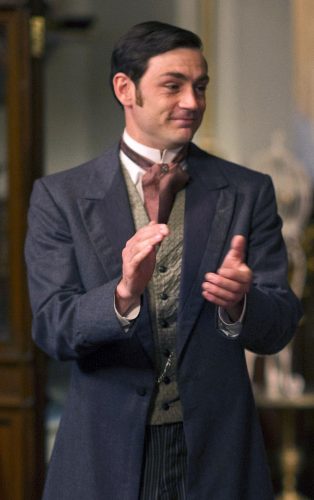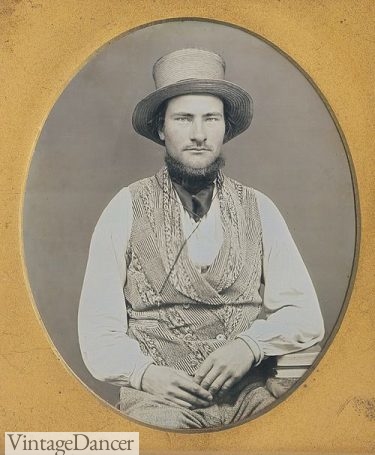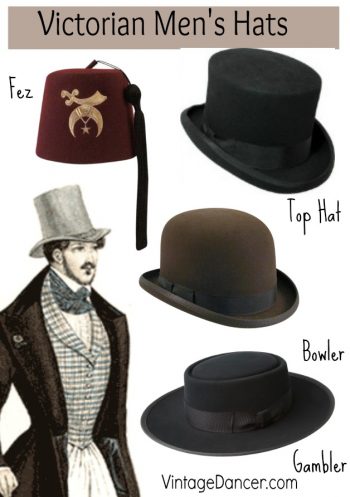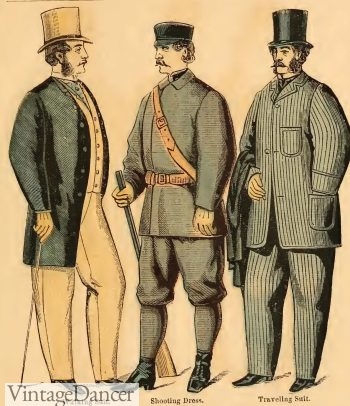The following explores Victorian men’s fashions from the pre-victorian 1830s to the late 1890s. It is sourced from Victorian Costume and Costume Accessories by Anne Buck, published in 1961. If you want to skip the history and learn how to create a Victorian men’s costume, this is the article for you.
Men’s garments of the Victorian period have survived in far less quantity than women’s. Throughout the period, the dress of men was generally a suit composed of coat, waistcoat and trousers, not always of matching material. A coat or cloak was added for outdoor wear. At any time, two or three variations of each garment would be in general use for each occasion of wear. Then one variety would become dominant, the others continuing for some time as old-fashioned wear, or being relegated to a definite and more limited use.
Victorian Men’s Trouser Pants
Of these garments, trousers are the rarest survivors. Waistcoats survive in quantity, coats are not scarce, but trousers are more rarely found. At the beginning of the period, trousers had just become well-established for general wear and breeches had almost disappeared, except for their survival in court dress and for riding.

1842 Prince Albert coat, brown jacket, yellow vest, check brown trousers
Pantaloons, which were tight-fitting garments reaching the calf or ankle, had been worn since the beginning of the century and were still worn, particularly with evening dress; but narrow trousers, with straps under the instep, were taking their place, and pantaloons were seldom worn after 1850. The straps under the instep also disappeared in the early 1850s.
For most of the period the trousers were narrow, with slight variation of width, but in the late 1850s and early 1860s the “peg-top” trouser, wide at the top of the leg and tapering to the ankle, was a distinctive fashion.
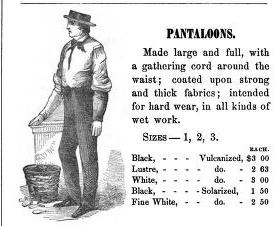
1859 catalog for mens pantaloons
At the beginning of the period, a fall-front was still in use, but the fly front was becoming increasingly used, and was general by 1850.
Knickerbockers, a loose form of breeches, appeared for sport and country wear in the 1860s and continued for this use until the end of the century.
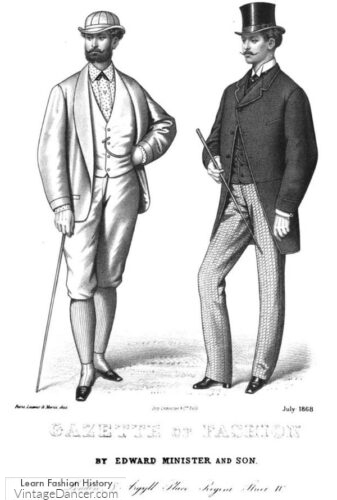
1868 knickers (breeches) and straight trousers
The pantaloons and trousers for evening wear at the beginning of the period were black cloth, and black trousers continued to be the only style for evening wear to the end of the century.
For daytime wear the trousers were usually of a contrasting color to the coat; white, fawn or pale grey in a fine milled cloth were fashionable, and striped, checked and plaid materials for less formal wear. The stout cottons, nankeen and drill, were still used for summer wear, although they were less common after the middle of the century.
The use of one material for coat, trousers and waistcoat appeared in the 1860s, particularly for the informal suit with the lounge jacket.
Buy Victorian men’s trousers and knickers
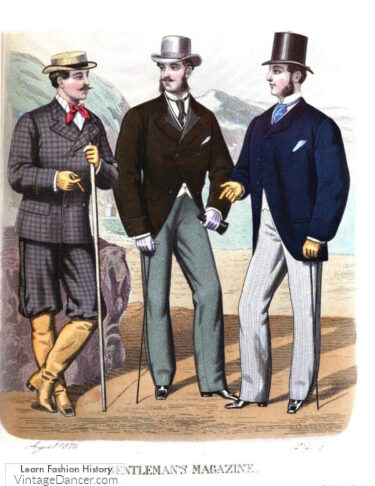
1876 knickers and long pants
Victorian Suits, Jackets, Coats
The frock coat was the usual coat form for day dress at the beginning of the reign. It was cut with a long waist and a short full skirt. It could be double-breasted or single-breasted. It was the dominant coat form for the 1840s and early 1850s and continued to be worn until the end of the century.
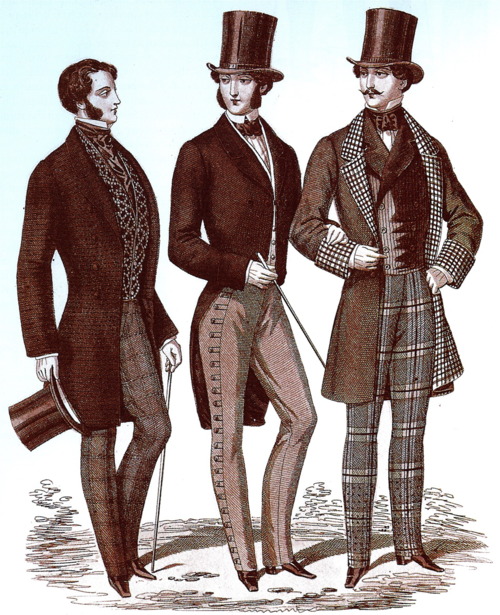
1840 coats -morning coat, cutaway coat, frock coat
During the 1840s, its fastening rose higher, shortening the lapels. The double- notched “M” lapel went out of fashion on frock coats by about 1850.
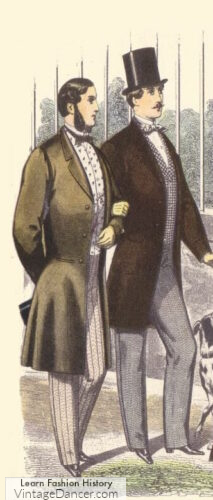
1861 frock coats
In the 1860s, there was less shaping for the waist, and the sleeves were wider at the shoulder, tapering towards the wrist. The sleeves thus repeated the line of the “peg-top” trousers and showed the same wide shaped form as women’s sleeves of the 1860s.
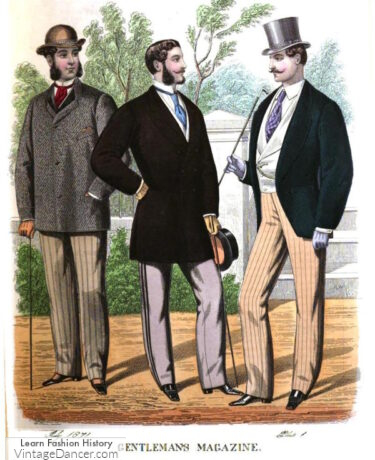
1871 men’s coats
By 1870 they had lost the shoulder fullness and were less shaped, falling straight to the wrist, where the cuff became more defined, closing with two buttons. The waistline rose in the 1890s and the lapels lengthened.
- 1876 Frock Coat, The Paradise
Although the frock coat was worn throughout the century, it lost its dominant position in the 1850s, when the morning coat began to replace it. A frock coat, with the skirt cut away in front in a curve from the waist, was worn as a riding coat in the 1830s and 1840s, and this shaping was adapted for a coat which gradually came into use as an alternative to the frock coat.
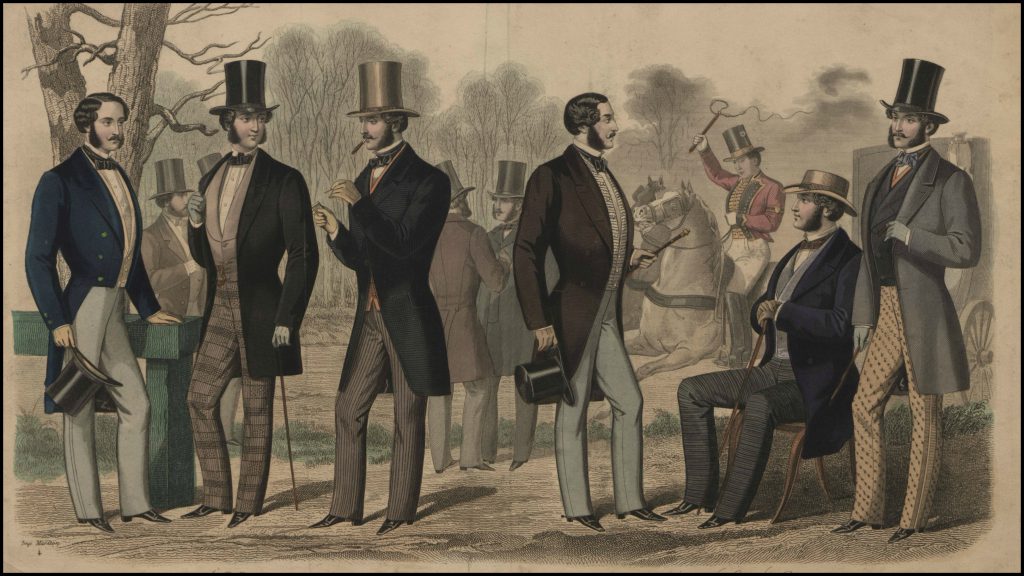
1857 men’s fashion
A jacket shorter than the frock coat or morning coat appeared by about 1850. Unlike these coats, it had visible pockets. It was a garment of informal wear for country or seaside, and it became general in the 1860s. Like the frock and morning coats, it had a sleeve wide at the shoulder and a straight loose line. It was made in both double-breasted and single-breasted forms.

1868 mens cutaway and frock coats
By the end of the 1860s, this jacket had also become accepted for general daytime wear. A belted form, with the jacket cut full and pleated back and front, was fashionable for country wear and was known as the Norfolk jacket. In the 1880s, the single-breasted forms had rounded fronts, a shaping which continued until the end of the century.
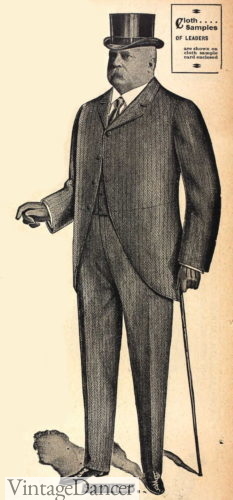
1899 made to measure cutaway suit
The tailcoat, with fronts cut away to waist level, which had been a style for both day and evening wear before 1830, had by the beginning of the reign become mainly a style for evening wear. It still appeared for formal daytime wear in the 1840s, but by 1860 it was an evening style only, and it remained the style of evening dress to the end of the century and beyond. It could be single- or double-breasted.
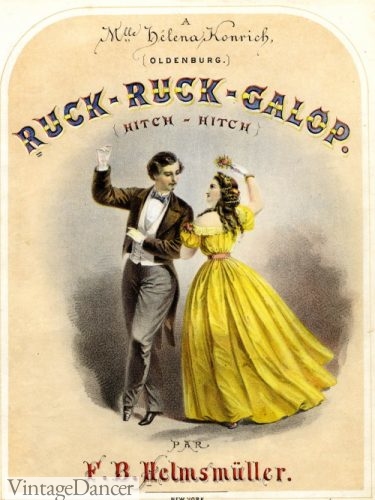
1840s dancing in a tailcoat
The evening dress form had long lapels revealing much of the waistcoat; the day dress coat, for as long as it was worn, had higher buttoning. The lapels were notched and the double “M” notch continued in the evening coat into the 1860s.
In the 1880s a style with roll collar appeared as an alternative to the separate collar and lapel, the roll collar curving low to reveal a large expanse of shirt front; both styles were worn in the 1890s. Sleeves wide at the top, and tapering to the wrist, also appeared in these coats in the 1860s.
Shop men’s Victorian suits, coats, capes and jackets
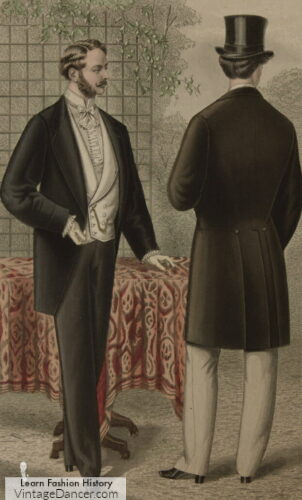
1873 dinner tuxedo jacket
In the 1880s another type of coat appeared for the less formal evening occasions. It had the new roll collar of the tailcoat of this decade, and the short form of the lounge jacket which had been adopted for day wear. By the end of the century it was known as a dinner jacket.
The evening coats were made of fine, milled cloth and from the beginning of the period were usually black or navy blue. Brown, dark green and mulberry color might still appear but, by 1860, a black tailcoats was the universal evening uniform.
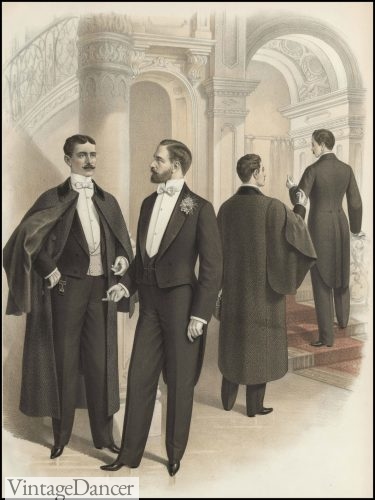
1894 evening dress in tailcoats
The frock coats were black, blue, brown or mulberry color, but by far the greater number of surviving examples are black or blue. Most are a finely milled cloth, but they were made in twilled and other cloth.
The lounge jacket had a much wider range of materials, including the lighter worsteds and tweeds. Dark grey was popular during the 1890s for all coats but the evening coat. Velvet collars appeared on dress and frock coats, particularly before i860. A fine cord edging is characteristic of coats from the beginning of the reign to about 1850.
Learn how to dress in Victorian men’s formalwear.
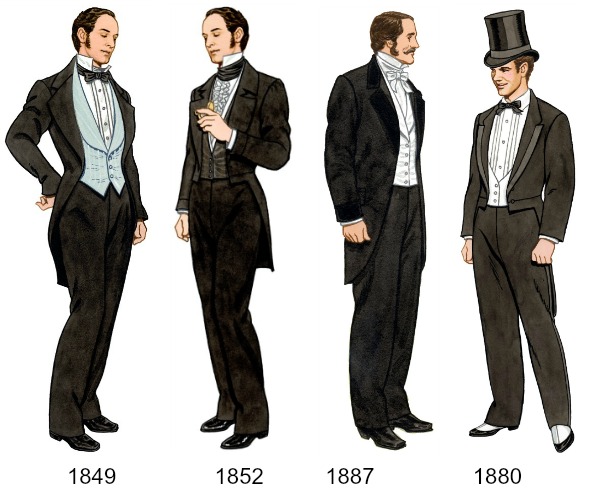
Victorian Men’s Eveningwear
Men’s Victorian Waistcoats / Vests
Most of the color and ornament of men’s dress was concentrated in the waistcoat, a garment which has survived in larger quantities than any other man’s garment of this period.
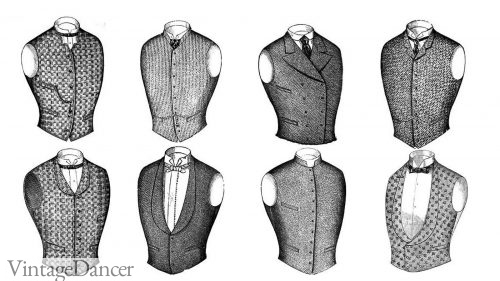
Most of the color and ornament of men’s dress was concentrated in the waistcoat, a garment which has survived in larger quantities than any other man’s garment of this period. Until the 1860s it showed the fabrics and colors and the woven and printed designs fashionable in the materials of women’s dress.
The tradition of embroidery for waistcoats, much of it now by the amateur, continued. The type of fabric and the degree of ornament depended on the occasion of wearing, but until the 1860s the waistcoat was usually indefinite but harmonizing contrast to coat and trousers, not only in color but in the texture of its material.
- Date unknown, probably 1860s
- 1860s
The higher fastening of coats, particularly the lounge jacket in the 1860s and 1870s, concealed much of the waistcoat, and this and the development of the wearing of coat, waistcoat and trousers of the same material, or coat and waistcoat alike with contrasting trousers, or trousers and waistcoat alike with contrasting coat, meant the eclipse of the waistcoat.
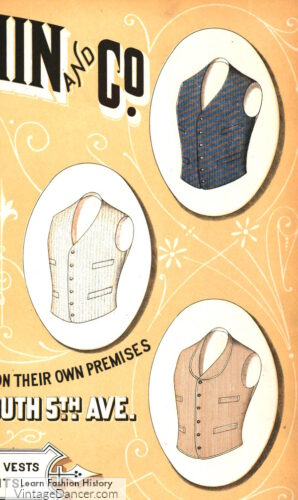
1881 men’s vests
“Fancy” waistcoats were revived in the 1890s, but beside the sure harmony or vivid splendor of the 1840s and 1850s their fancy appears hesitant and characterless.
Many of the waistcoats which survive have been preserved because they were wedding waistcoats. These were often in white or cream figured silk, or white silk embroidered, although many examples have survived as wedding waistcoats which do not follow this fashion. For evening wear, also, the waistcoat was often white, in many different kinds of silk at the beginning of the period, but black evening waistcoats were fashionable in the 1860s and 1870s; only in the 1890s did white marcella or pique become the usual wear, the black waistcoat remaining with the dinner jacket.
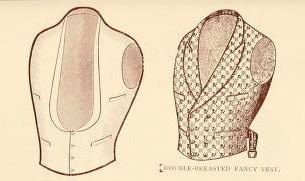
1894 white eve vest or fancy design shawl collar vest
In the 1840s, the dress waistcoats of day wear and informal evening wear were in figured silks and satins very like the fabrics of women’s dress at the time. Plain silks and satins were embroidered, usually in a bordering pattern and on the pockets. At the beginning of the period, the liking for bright patterns on a dark background which appeared in women’s aprons, bags and shawls, appeared also in waistcoats, with cross-stitch patterns in brightly colored silks on a black or dark satin ground. Fine white or black twilled wool was also used and embroidered.
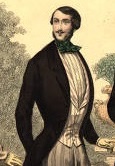
1848 waistcoat
In the 1850s, there was an increasing fashion for tartan patterning in silk and velvet and the colors grew brighter in daytime wea. Although examples of dress waistcoats in figured velvets and similar materials survive from all periods up to the last years of the century, there was, after 1860, much less use of silk, particularly for daytime wear, and even when waistcoats did not match the cloth of coat and trousers, they were often in a woollen fabric with pattern limited to a fancy weave in a single colour.
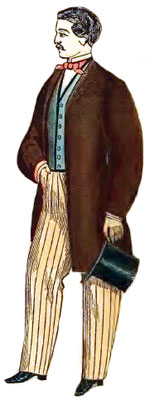
1860 straight bottom waistcoat
The waistcoats of the 1840s often show a pointed, rather long waistline. In the 1850s, the fronts were slightly cut away, a small triangular gap at the center waist.
In the late 1860s, the waistline became shorter and the line at the waist was less pointed and nearer the horizontal. This movement of shortening and straightening at the waist kept in time with the more conspicuously changing line in women’s dress.
The waistcoat lengthened a little in the 1870s and 1880s, but generally kept the horizontal line until the 1890s, when the day waistcoat again showed a small gap at the center waist.

1875 gold brocade waistcoat in the Paradise, 1874
In the 1840s, the single-breasted form was general, although the double-breasted form appeared, particularly in plainer examples for daytime wear. For day wear, double-breasted forms increased in popularity during the 1850s and 1860s. The single-breasted form was more usual for evening wear throughout the period until the last years of the century, and particularly before 1870.
For day wear, both types were worn to the end of the century. There were usually two pockets, sometimes three, until 1870; then three were usual and four occasional. Crescent-shaped pockets on waistcoats are usually a sign of an 1830s or 1840s date.
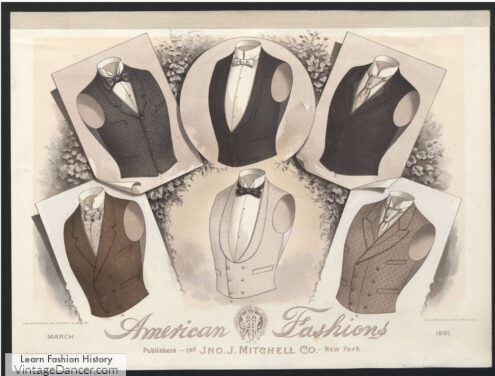
1891 men’s vests
The neck opening at the beginning of the period often had the collar continuous with the lapel, the opening being wide and deep; during the 1850s, the fastening rose a little higher and there were a larger proportion of waistcoats with a separate collar and lapel, the lapels often being wider and shorter; but the earlier form remained in fashion, particularly for evening wear.
Waistcoats buttoning high, with or without a collar but without lapels, were worn in the 1860s. A deep opening appeared again in the 1870s, mainly in double-breasted styles. In the single-breasted styles, the fastening was higher and the collar and lapels were small, or there might be no collar. A higher fastening was general on all waistcoats in the 1890s except evening waistcoats, on which the opening widened and deepened in the 1880s and 1890s.
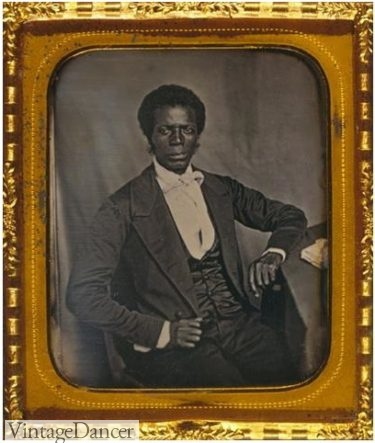
At the beginning of the period the back of the waistcoat was usually tightened by tapes threaded through tabs sewn at the back. The tapes might be sewn d1rectly on to the waistcoat back, but this was a survival of the eighteenth-century style, which was going out of use by 1840. Tabs which have metal eyelet holes all fall within the period.
After 1845, ties were being replaced by a strap and buckle, although the older method continued in use for many years. Leather facings were used at the base of the waistcoat fronts in the late 1840s and early 1850s. Darts under the lapels appeared mostly in waistcoats of the 1840s. The back and lining were usually of glazed cotton, but silk was sometimes used for evening waistcoats. Linings of striped cotton appeared in waistcoats for day wear from the 1860s.
At the beginning of the period, and until about 1850, underwaistcoats were sometimes worn, to show at the opening of the waistcoat. These, which were a continued fashion from the 1820s and 1830s, were either collar and lapels only, or a short waistcoat.
Shop men’s waistcoats and vests
Victorian Men’s Shirts
Linen shirts with a high collar and frilled opening were still being worn at the beginning of the period, and the frill remained on evening shirts until about 1850, when it was gradually replaced by a front section of vertical tucking or pleating, the opening being fastened by buttons or studs. This fastening was already used for shirts of day wear from the beginning of the period.
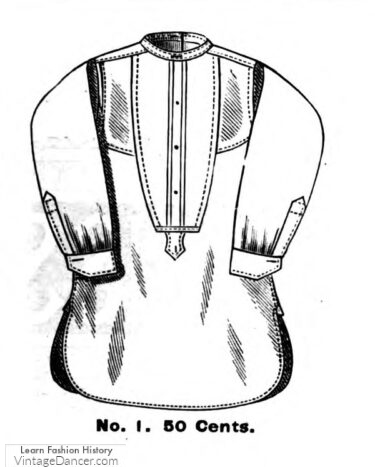
1881 men’s basic shirt
A small frill sometimes remained around the vertical section containing the buttons and buttonholes, which was a decorative feature of shirts in the 1850s and 1860s.
After 1870, shirt fronts became plain. Shirts with decorated fronts sometimes had a back fastening, and some a side fastening.
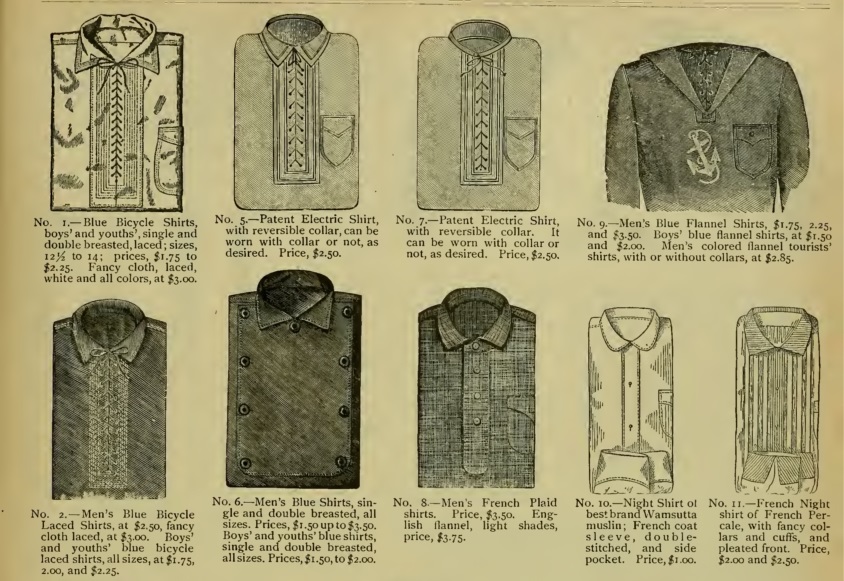
1882 casual sporty men’s shirts
After 1850, the corners of the shirt, where the seam opened at the base, were rounded. Striped cotton shirts were used for sporting and country wear from the beginning of the period, but not until the last years of the century were colored shirts accepted for formal day wear.
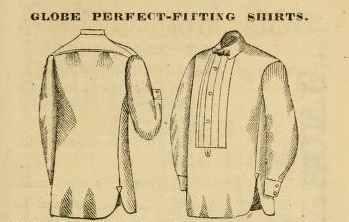
1880 men’s dress shirt
The collar became lower during the 1840s and 1850s, when it began to turn down over the cravat. Detachable collars were worn from this time, and collar and cuffs and shirt front show an increasing stiffness in the second half of the nineteenth century.
Collars with ends high in front were worn in the 1850s, but the collars of the 1860s and 1870s were low. They were now either single or double, the double being used only for daytime wear. The single collars were upright, with a gap at the center front, or with the corners turned down.
After 1880, the collar in all forms grew higher and, for most of the 1890s, was between two and a half and three inches high. This high collar appeared in both men’s and women’s dress in the 1890s.
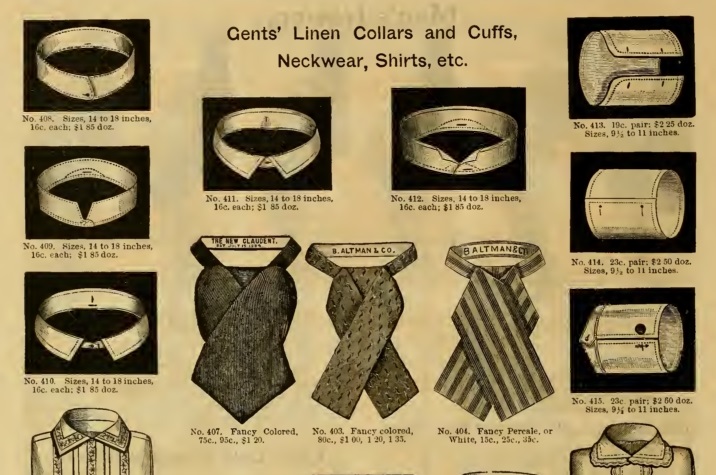
1886 men’s shirts, collars, cravat
Victorian Ties and Suspenders
In the late 1830s, the neckcloth or cravat was still a piece of white muslin, folded into a band, wrapped around the neck in front and brought from back to front again to tie in a great variety of knots. Black silk was becoming increasingly worn for daytime, and also colored silk both plain and figured. A stiffened, made-up band, with or without a bow in front, was also worn. It was then called a stock.
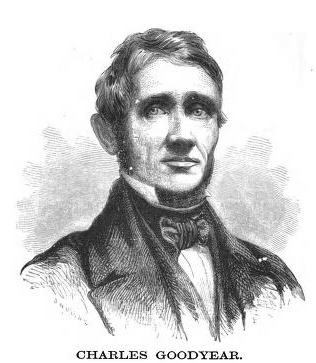
1856 Charles Goodyear stock tie
By the end of the 1840s, white was unusual except for evening wear. After a period in the 1840s when black cravats were fashionable for evening wear, white remained usual for full evening dress for all the rest of the period, whatever the shaping of the cravat or tie. There was a change in the tying of the cravat in the 1840s, when the neckband was made narrow and the bow or knot very large. The cravat was sometimes knotted loosely as a scarf, fitting the opening of the waistcoat and fixed by a pin.
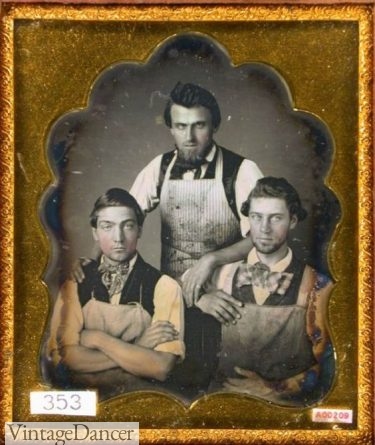
1860s bow ties
By 1860, the collar of the shirt had become much lower and was turning down in front. The cravat was now a narrow band of material, usually less than an inch wide, tied in a small flat bow in front or knotted and fixed by a pin. These very narrow ties are characteristic of the 1850s and 1860s.
The tie now made as a shaped band, narrow in the center for the neck, wider at the ends, was tied in a bow or knot during the 1870s and 1880s.
In the 1890s, when the collar became higher, many varieties of knot and a great variety of materials were used in ties.
Shop Victorian neckties, cravats, ascot and bow ties
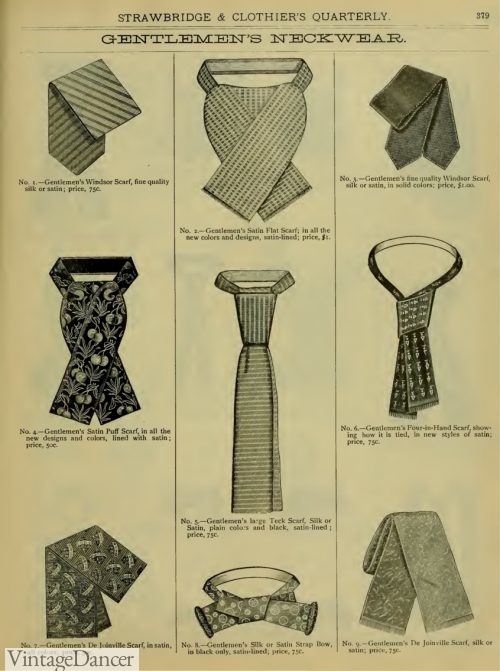
1882 men’s neckwear
One of the most decorative accessories of men’s dress during the period was its braces. Braces (suspenders) of canvas, embroidered in colored silks and lined with silk, were fashionable in the 1830s and 1840s. Later they were embroidered in wool. They were made in two separate bands, with leather tabs with buttonholes, one end adjustable with a buckle.
Braces joined at the back appeared N in the second half of the century, but directions for making braces of the earlier pattern still appeared in magazines of the 1860s. “Braces form a necessary adjunct to a gentleman’s wardrobe and they are generally pleased to have them prettily worked” (English- woman’s Domestic Magazine (Patterns, Fashions and Needlework, 1865).
Braces were also made in knitted and crocheted cotton.
Shop suspenders/braces
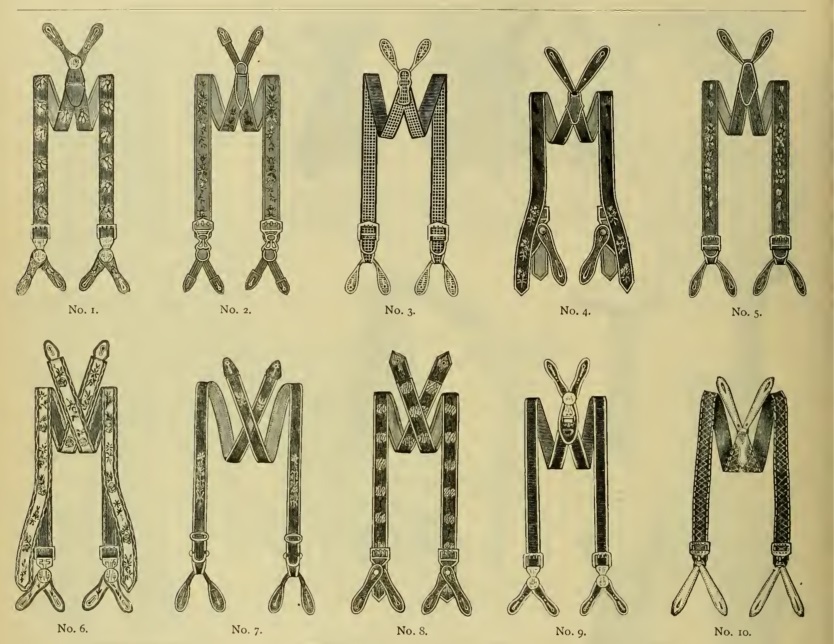
1883 suspenders
Men’s Victorian Jewelry & Accessories
“The man of good taste will wear as little jewelry as possible. One handsome signet-ring on the little finger of the left hand, a scarf-pin which is neither large, nor showy, nor too intricate in its design, and a light, rather thin watch-guard with a cross-bar, are all that he ought to wear. But, if he aspires to more than this, he should observe the following rules:—
- Let everything be real and good. False jewelry is not only a practical lie, but an absolute vulgarity, since its use arises from an attempt to appear richer or grander than its wearer is.
- Let it be simple. Elaborate studs, waistcoat-buttons, and wrist-links, are all abominable. The last, particularly, should be as plain as possible, consisting of plain gold ovals, with, at most, the crest engraved upon them. Diamonds and brilliants are quite unsuitable to men, whose jewelry should never be conspicuous. If you happen to possess a single diamond of great value you may wear it on great occasions as a ring, but no more than one ring should ever be worn by a gentleman.
- Let it be distinguished rather by its curiosity than its brilliance. An antique or bit of old jewelry possesses more interest, particularly if you are able to tell its history, than the most splendid production of the goldsmith’s shop.
- Let it harmonize with the colors of your dress.
- Let it have some use. Men should never, like women, wear jewels for mere ornament, whatever may be the fashion of Hungarian noblemen, and deposed Indian rajahs with jackets covered with rubies.
- The precious stones are reserved for ladies, and even our scarf-pins are more suitable without them.
– From The Gentlemen’s Book of Etiquette, 1860
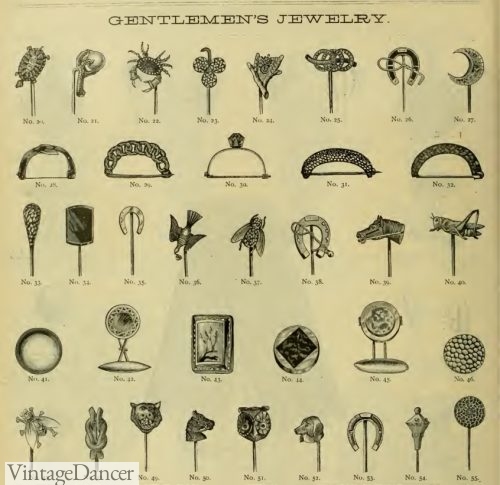
1883 men’s jewelry stick pins, scarf pins, scarf rings, shirt cuff links
Victorian men wore gloves daily. Daytime gloves could be leather or cloth in dark colors – tan, grey, brown that hid dirt and germs. Evening gloves were always white. Gloves were removed while eating, smoking or generally inside. Hats and gloves were usually removed upon entry into a home.
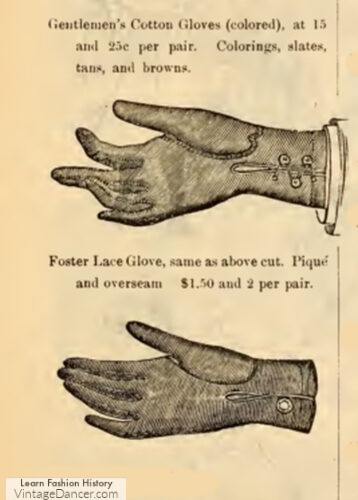
1897 men’s button wrist gloves
Gauntlet gloves were longer cuffed gloves worn for work, driving or winter conditions. Shorter kid leather gloves were daywear types with a button over the wrist. In winter many were lined in fur. There were fur lined or knit mittens as well. Shop men’s gloves.
An English writer, ridiculing the whims of Fashion, says:— (quoted 1860)
“To be in the fashion, an Englishman must wear six pairs of gloves in a day:
“In the morning, he must drive his hunting wagon in reindeer gloves.
“In hunting, he must wear gloves of chamois skin.
“To enter London in his tilbury, beaver skin gloves.
“Later in the day, to promenade in Hyde Park, colored kid gloves, dark.
“When he dines out, colored kid gloves, light.
“For the ball-room, white kid gloves.”
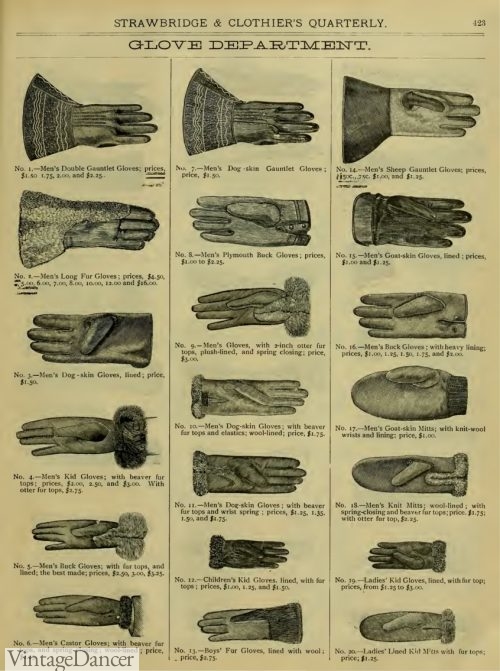
1883 men’s gloves
Men’s Coats and Capes
Outdoor coats and capes for men are rather rare survivors. The cloak was still worn for evening, but became less general after the 1860s, although never completely out of fashion. Short cloaks and short-sleeved capes were also worn in the 1850s and 1860s.
One of these which became much used, particularly for the overcoat most generally fashionable throughout the reign was the Chesterfield. This had no waist seam and was straighter and looser than the frock coat.
At the beginning of the period it had slight shaping for the waist, but became straighter after 1860. There were both single- and double-breasted forms and also, after 1850, a style with concealed front fastening. There were also short coats, the lounge jackets of outdoor wear.

1863 mens suits and overcoat (center)
Those of the 1850s and 1860s were distinguished by very large buttons, a characteristic which was borrowed with these jacket forms by women’s dress. Overcoats of the 1860s also showed the wide, shaped sleeve, a characteristic detail of this decade which is found in the dress of both men and women. The raglan sleeve, cut up to the neck on the shoulder, appeared in overcoats in the late 1850s and 1860s and was again fashionable in the late 1890s.
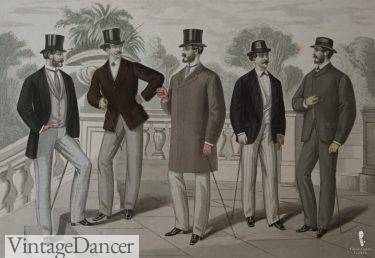
1870s
The short coat of the 1880s and 1890s was the covert coat, which was a short Chesterfield, with concealed front fastenings. A very long, belted overcoat, the Ulster, appeared in the 1870s and was particularly popular as a travelling coat. In the 1890s, it was usually worn with a half-belt at the back only. The full-length coats varied in fashionable length, ending as high as the knee, or as low as mid-calf, until the 1890s, when all coats lengthened to end between calf and ankle. The heavier milled cloths and tweeds were used for these outdoor coats, mainly in black, dark blue, grey and brown shades.
Shop men’s coats and outerwear
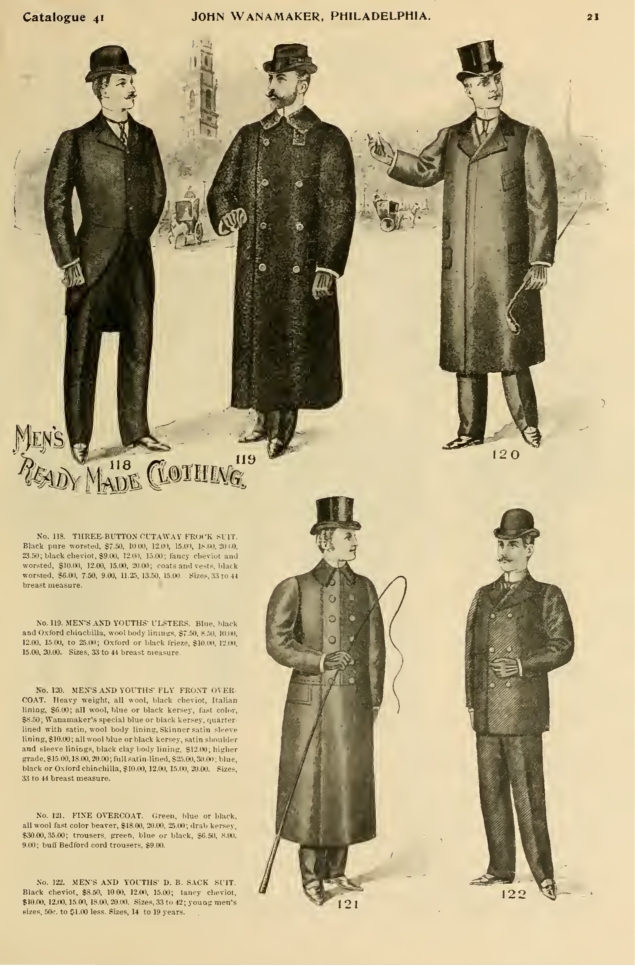
1896 men’s coats
Men’s Victorian Hats
The top hat, with a high, flat-topped crown and narrow brim, was worn throughout the reign. At the beginning of the period, the crown was high, about seven or eight inches, and the sides curved out slightly at the top; the narrow brim curved up slightly at the sides. This hat was worn for all occasions in silk, beaver, felt and straw, in black, fawn, grey or white. A collapsible form was in use for evening wear. A lower-crowned, broader-brimmed style was worn in the country and unfashionably.
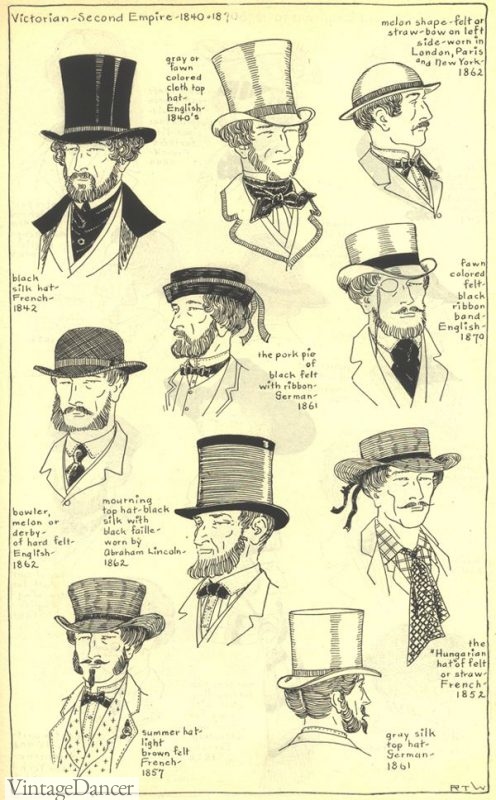
Victorian mens hats 1840-1890
During the 1850s, the silk form of the top hat became dominant, and the low-crowned hats were usually of felt or straw. Straight- brimmed straw hats, the sailor shape of the time, appeared for informal summer wear, and a round cloth cap was also worn for sport and in the country.
A new form, the bowler, or round-crowned, hard felt hat, was added to the hats of informal wear in the 1860s. In the 1870s, a hat with dented crown and curving brim, which later, in the 1890s, was given the name of “Trilby”, also appeared in soft felt and straw.
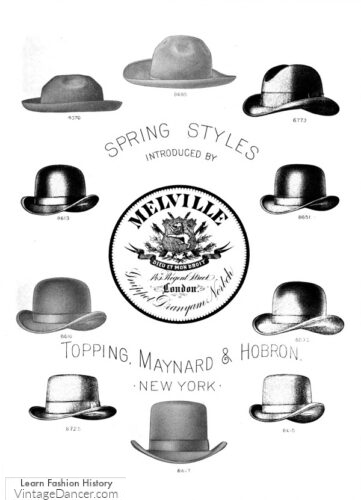
1884 men’s hats
The most popular informal hat of the 1890s was the straw boater, a stiffened straw with flat, round crown and straight brim. A development from the sailor shape of the middle of the century, it entered informal town wear by way of tennis and boating in the 1880s.
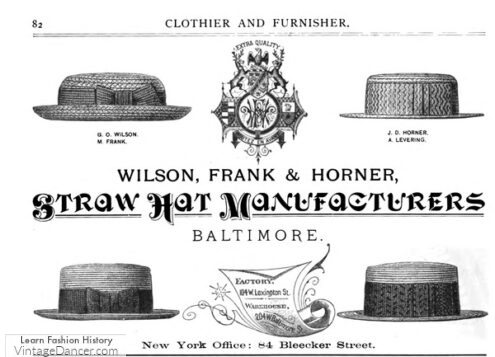
1887 straw hats
The deerstalker cap, a cap in tweed with flaps which could be tied over the ears or over the top of the cap, was a country and sporting fashion of the 1880s and 1890s.
There were also a number of variants of the main types of hat, such as a flat-top bowler, a stiff trilby—known as the Homburg—and a tweed helmet, with peaks at the back and front.
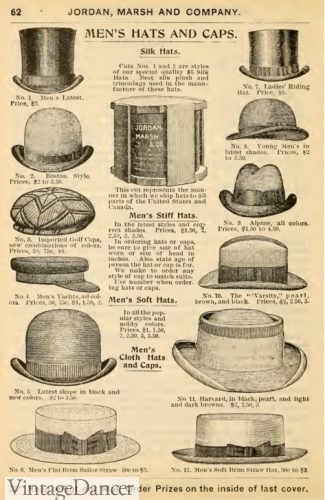
1897 men’s hats- tops hats, bowler, trilby, golf cap, yacht cap, homburg, gambler, and straw boaters
The top hat remained tall until the mid-1860s, when its crown lowered to about six inches. In the 1880s, the crown of this hat, and that of the bowler—which was worn with lounge suits— became higher; but in the 1890s, both were lower again.
For all formal wear, with frock coat, morning coat and evening dress, the high hat remained fashionable until the end of the century. For less formal town wear the bowler, usually also black, was the main style. Brown, grey and fawn appeared in the softer felts and, as a sign of summer, in the bowler.
Dark and speckled plaits were used in straw hats, although the natural-colored straw was the more general fashion. Shop Victorian style men’s hats here
Men’s Shoes & Boots
High boots, reaching just below the knee with a curving top, were known as Hessians, and with a straight plain top as Wellingtons. These still continued in wear for walking, but the shorter half-boot forms were more usual.
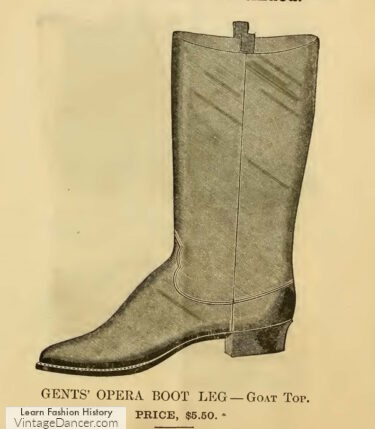
1855 tall boot (high boot)
The commonest form of the half-boot was the Blucher, a half-length Wellington, with front lacing. From 1837, boots with elastic gussets at the side were worn, and men also wore boots with leather toes and cloth tops, with side lacing, matching those worn by women.
After 1850, long boots disappeared except for riding. The leather and cloth boots with side lacing also disappeared, but the elastic-sided boot continued to be worn and did not entirely disappear from old-fashioned use until the end of the century.
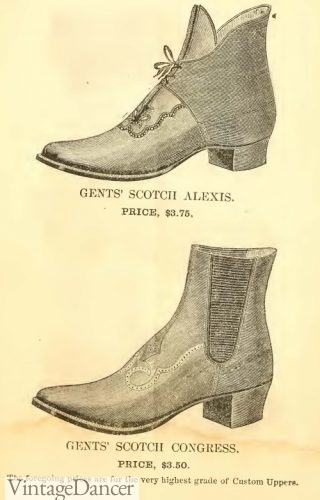
1855 men’s boots
Button boots, which had appeared in the late 1830s, became fairly common in the 1860s, and they were particularly fashionable in the 1870s and 1880s. The front lacing boots from the late 1860s might have metal hooks instead of holes at the top, to hold the laces.
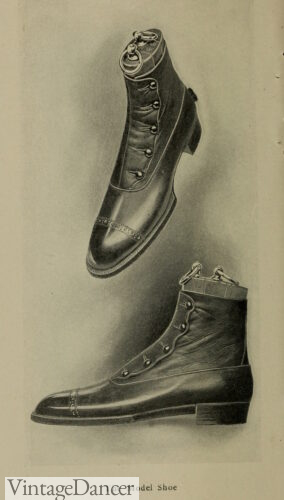
1898 mens button boots
At the beginning of the period, there were two types of shoe: one the dress shoe, which was a light low-heeled pump with a low front; and the other a shoe with latchets and lacing over the front, which was low-heeled but still suggestive of the style of the eighteenth century.
In the late 1840s, a shoe with lacing up the front appeared. Buttoned shoes came into use with buttoned boots in the 1860s and were worn during the 1870s and 1880s. Boots were, however, still the usual wear until the end of the century.
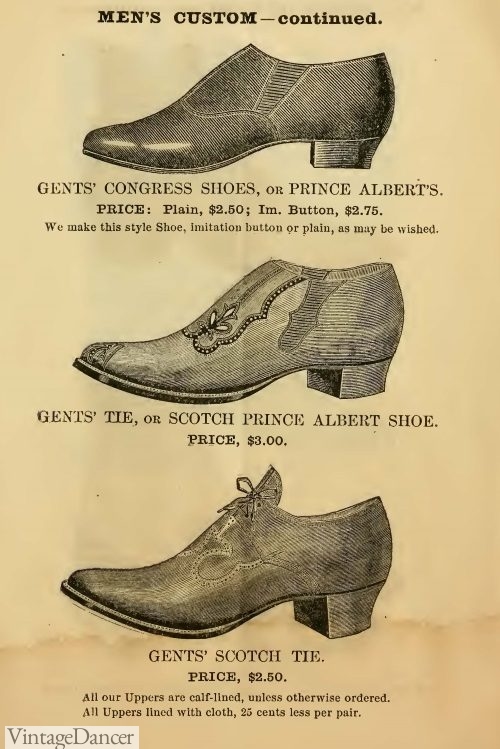
1855 men’s shoes
Boots and shoes were square-toed and rather long and narrow in shape at the beginning of the reign. They became wider in the 1860s; at the same time the toe rounded a little, and then during the 1880s became pointed. This change of shaping came to the boots and shoes of men and women alike.
Buy men’s Victorian boots and shoes

1895 lace up men’s boots
Stockings were usually knee-length at the beginning of the period. They were white, black, speckled or striped, and were made of silk, wool or cotton. During the century they grew shorter. Gaiters might be worn in the country in the first half of the period, and short gaiters or spats, which covered the ankle only, were fashionable town wear from the 1870s to the end of the century.
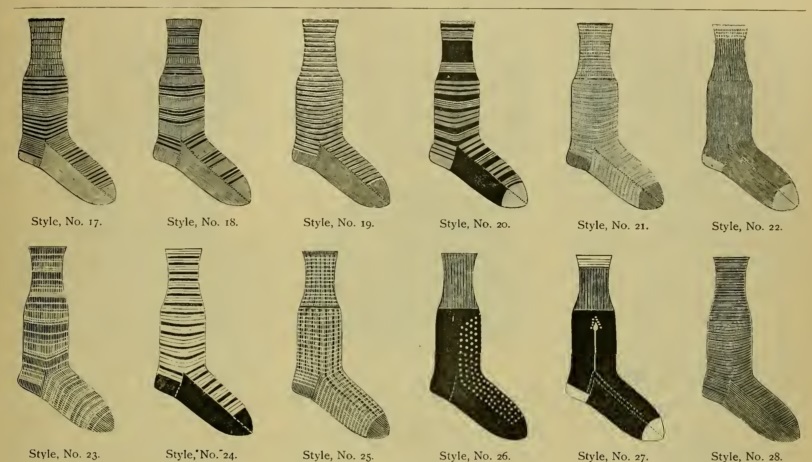
1883 Men’s Socks
Victorian Men’s Sports Clothing
The fashions of men are more influenced by the occasion of wearing, less by the precise moment of time at which they are worn, than women’s. Evening dress preserved the early coat style with square cut-away front to the end of the period and beyond. Riding dress also kept this form until the 1850s.
The early nineteenth-century coat with curving cut-away, known as the Newmarket coat, was, on the other hand, used first for riding, and then in the 1850s came into use as the morning coat. For riding, trousers of white cord were much worn in the first half of the period; for hunting, breeches continued to be used.
The hunting coat was usually a short frock coat of scarlet cloth, although green was still worn at the beginning of the period. Shooting jackets were, at first, short frock coats, and then the shorter lounge jacket. Both forms are distinguished by a number of visible pockets.
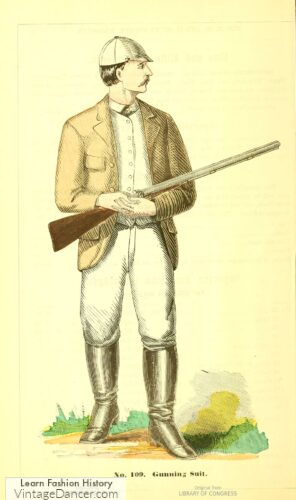
1875 hunting outfit
The Norfolk jacket was also a fashion for shooting in the 1860s and, unlike the lounge jacket, never left the country. For cricket and tennis, short jackets with patch pockets were worn. These jackets, which were often brightly colored and by the 1890s were known as blazers, also remained limited to sporting wear.
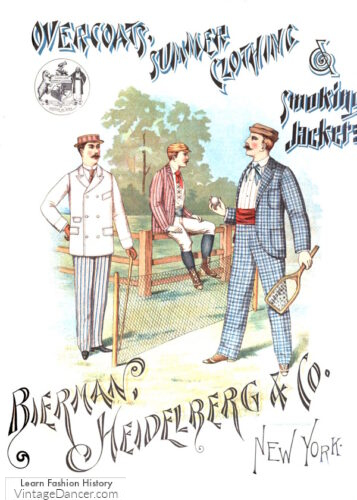
1890 sport suits
The habit of smoking also produced its jacket, a loose lounge jacket, usually of velvet or heavy silk, sometimes quilted and trimmed with silk cord. Smoking jackets were worn from the 1850s until the end of the century. A smoking cap was sometimes worn with a smoking jacket; this was a round flat cap, made in the pork-pie shape of velvet, silk or cloth, braided or embroidered and often with a tassel. Illustrations for making and decorating these caps appear frequently in fashion journals of the second half of the century, and the caps, many obviously unworn, survive in quantity.
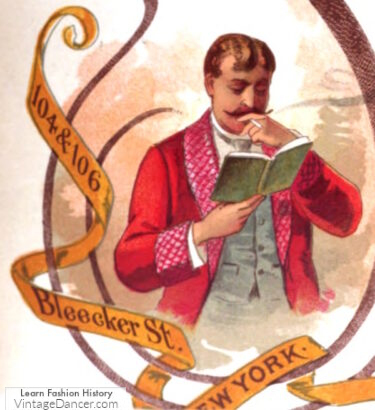
1887 smoking jacket
Next, How to create Victorian-era men’s outfit or costume.
Shop for men’s Victorian era clothing in the USA and Victorian era clothing in the UK
Debbie Sessions has been teaching fashion history and helping people dress for vintage themed events since 2009. She has turned a hobby into VintageDancer.com with hundreds of well researched articles and hand picked links to vintage inspired clothing online. She aims to make dressing accurately (or not) an affordable option for all. Oh, and she dances too.
